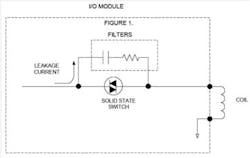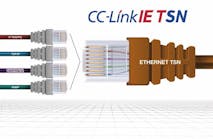As fluid-automation users embrace the latest-generation devices, challenges can arise that do not occur with older, high-power-consumption equipment. At issue here are supervisory and leakage currents generated by control-system I/O. Such currents can cause problems when interacting with the latest low-power components, such as solenoid valves and sensors.
We will here review relevant concerns when applying low-power and electronically enhanced solenoid valves within certain control systems; outline and show how to identify the limited set of cases where problems can exist; and suggest solutions, tips and workarounds to be considered in consultation with suppliers and product manuals.
In process plants, low-power solenoid valves act as pilot valves that open and close larger ball or butterfly valves. They’re also found on control valves, for fail-safe air release, if there’s power or air loss. They work by pressurizing or depressurizing associated actuators.
Latest-gen, low-power valves — such as those from ASCO Numatics — draw only about 0.5 W, as opposed to the previous low-power standard of around 1.5 W. Today’s offerings are efficient and accommodate power-consumption limits imposed by bus networks, backup power schemes and remote locations. All this has been welcomed by original equipment manufacturers (OEMs) and valve assemblers, as well as by end-users — in fact, anyone who specifies solenoid valves for oil & gas, chemicals, pharmaceuticals & life sciences, food & beverage or power & steam.
Advances in low-power solenoid valves are not always matched by necessary I/O changes. A mismatch between control system and valve can bring unintended consequences. Where problems do arise, a valve can "hang" or stay open when it should close, allowing process media flow to continue.
Tales of the unintended
The potential problem doesn’t come into play for most applications using relay-type output controls to operate solenoid valves. However, where the valve is managed by solid-state I/O modules, some users may encounter problems. Equipment specifiers should match the new valves with the right I/O module (or consider other steps, as outlined below) for reliable operation.
Problems that do arise are due to either supervisory or leakage current. Supervisory current is a low-level loop current found on some traditional PLC/DCS output modules. It’s part of a diagnostic scheme that module manufacturers devised to verify the presence of open circuits, i.e., that as long as a load is connected to the module, current should flow. Only when the load is disconnected — creating an open circuit — should current draw be zero. So even "off," a small amount of current flows for these modules.
Somewhat more common than supervisory current is problematic leakage current, which is not part of any diagnostic scheme, but rather unintended, residual current produced in a module’s "off" state.
Ideally, "off" should produce zero flow. However, in some I/O modules, electrical filters — that protect against power surges and transient voltage spikes caused by inductive loads — leak small amounts of output current. Also, the off-state impedance of some solid-state switching devices is low enough to allow current to flow (See Figure 1).
Leakage current is mostly present in solid-state AC applications using triacs. It can also be found in DC I/O modules.
Affected low-power valves
Again, low-power solenoid valves are impacted by output module mismatch. A low-power coil operates at a much lower current than a standard solenoid valve. (It thus de-energizes at a lower current also, termed the drop-out current.) In some cases, a valve with an extremely efficient magnetic design operates with only a few milliamps of current.
Unfortunately, some existing I/O modules designs assume solenoid valves might draw as much as 6 to 10 W, and not less than 1.4 W. Any leakage or supervisory current the module emits is below these levels, ensuring the solenoid valve is maintained "off," keeping it de-energized.
However, the latest solenoid-valve generation draws only about 0.5 W. So some output modules may generate a high enough leakage or supervisory current to inadvertently affect valve operation.
Besides low-power valves, two recent electronically enhanced solenoid-valve types can encounter problems, including those having an option for a charging circuit that stores energy on capacitors. Typically, an I/O module with problematic supervisory or leakage current produces enough flow to charge up these capacitors, keeping the valve in an undesired energized (open) state.
Another challenge, found on a few electronically enhanced solenoid valves, involves peak and hold pulse-width-modulation (PWM) circuits. This type power-management circuit delivers a higher inrush current to energize the valve, and then reduces power to hold the valve open. Thus power to the valve is switched on and off at a fast pace (i.e., at a high frequency). The longer the valve is kept switched "on," the more power the valve consumes.
A PWM circuit has a lower holding mode, reducing power and coil heat rise. However, because holding-power levels are lower than the standard valve power levels, supervisory and leakage currents can prevent proper valve closing.
Testing the currents
Supervisory or leakage current doesn’t necessarily impact solenoid valve operation. How do you know whether it is or not?
One simple field test is an initial indicator for most affected applications. With a normally closed (NC) valve, the problem manifests when the solenoid sticks "open," even though the output module is turned "off." A user can tap the valve lightly, or slightly lift the solenoid. This helps overcome the magnetic force generated by supervisory or leakage current, releasing the valve core and returning the valve to "closed." If a simple tap or lift allows the valve to shift, a current problem probably exists.
To confirm, employ an amp meter or current probe. With the I/O module "off," check for current output. If current is detected, it’s a supervisory/leakage current situation. For modules that "pulse" current, an oscilloscope will be needed.
Where current is discovered, the next step is to determine the valve’s drop-out current, i.e., at which the valve shifts back to "closed."
If supervisory/leakage current is less than the drop-out current, valve operation will not be affected (See Figure 2). No further action is necessary.
However, if supervisory/leakage current is greater than drop-out current, the valve will seem stuck in the open position when de-energized (See Figure 3).
Industry-accepted workarounds
Those with current leakage problems find the following helpful. Bear in mind, however, that here not every unique situation can be addressed. Consult the appropriate engineering disciplines and your suppliers for definitive answers.
In existing installations, for supervisory current, try switching software to passive mode. Digital output modules that use supervisory current often have mode settings. In "active," supervisory current flows constantly through each output module.
However, should active mode prohibit proper component operation, users can switch to "passive." Here current is usually pulsed rather than continually applied (See Figure 4). In this pulsed mode, "on" time is significantly shorter than "off" time and valve operation isn’t affected. Further, "on" pulse magnitude is lower than the pick-up current. Thus, the solenoid valve will not turn "on" inappropriately, despite supervisory current presence.
Other I/O modules are configured so that passive-mode supervisory current only occurs once the valve has been cycled "on/off." In this mode, the I/O module checks for open circuits only when in the "on" state. Here again, the valve will not turn "on" inappropriately.
In existing installations, for leakage current, try applying a loading resistor. Unlike supervisory current, leakage current cannot be managed via software settings. Primarily caused by electrical filters built into the I/O module to guard against electrical anomalies, leakage current is present 100 percent of the time in the "off" state.
However, PLC and DCS makers often recommend using a loading resistor. With a particular resistance and wattage in parallel with the valve, the resistor absorbs excess current, and ensures that across the valve it remains below the "off" state drop-out current. This eliminates or limits problematic leakage-current effects. Adding a resistor is by far the simplest solution, especially if the output modules are in a control-room marshalling cabinet.
Maker resistor value and wattage vary depending on leakage magnitude and voltage. Area classification (Class I, Division 1 or 2) also affects what is done to limit leakage current effects. Consult the literature or ask the manufacturer for accurate information.
New or upgraded installations
For supervisory current in new or upgraded installations, select the right I/O module. For a control-system upgrade, the right output module helps ensure trouble-free, low-maintenance operation.
- If supervisory current is needed as part of a diagnostic scheme to detect open circuit conditions:
- Consult the maker for drop-out current of the low-power solenoid valve used.
- Select an up-to-date output module with supervisory current lower than the valve drop-out current.
- If valves are the last components selected, first choose a compatible, modern output module, with both active and passive modes for detecting open circuits. Operate in passive mode.
- If possible, select a module where supervisory current is pulsed and present 100 percent of the time.
With new or upgraded installations, for leakage current, select the right module, apply a resistor or try surge suppression.
- If supervisory current isn’t needed:
- Consult the I/O module data sheet as to any current leakage.
- Consult the valve maker as to drop-out current for the valve intended.
- If leakage current is less than the drop-out, the valve isn’t compromised.
- If leakage current is greater than drop-out, connect a loading resistor to the valve. Consult the literature or manufacturer to ensure the suitable resistor.
Another option is using the surge-suppression version of a low-power coil. Surge suppression coils that are not polarity-sensitive contain diodes in series with the coil windings. In some cases, the added power drop across the diodes is enough to keep leakage current from keeping the valve energized.
With new or upgraded installations, for leakage current, adjust your expectations about coil wattage.
Choosing appropriate coil wattage also ensures proper valve operation with a selected I/O module. Once the output module is chosen and any leakage current magnitude verified, select valves with coil drop-out current greater than leakage current. Resistors and surge suppressors are unnecessary — a preferred outcome, especially for remote upgrades, where adding components after installation is expensive.
Of course, sufficiently high leakages effectively rule-out use of the latest low-power valves, depriving you of power-savings opportunities. If this is the case, instead of models drawing 0.5 W, consider higher-power valves.
Match the low-power revolution
Demand for increased efficiency drives the low-power valve and sensor revolution. Concomitant with low-power solenoid valves, I/O cards have been introduced with either pulsed or lower-current off-state supervisory systems. Further innovation will benefit both I/O suppliers and users. Lower power consumption per valve will lead to there being more I/O points in an I/O card, reducing system installation costs.
Latest generation, low-power electronically enhanced solenoid valves are efficient and save energy, as well as installation and equipment costs. Although enthusiastically embraced by OEMs and users, the valves can be mismatched with I/O modules that generate problematic currents. Workarounds and solutions include I/O modules that accommodate these valves. Pairing these low-power valves with the latest I/O module delivers the best possible performance going forward.
Manny Arceo is principal engineer and Jack Haller is manager of electronics and magnetic at ASCO. Contact them at [email protected].
ASCO Numatics, a division of Emerson, offers fluid-automation solutions, including fluid-control and fluid- power products for industrial applications. The ASCO Numatics product line in North America includes more than 50,000 valves, air-preparation equipment and actuation products.






